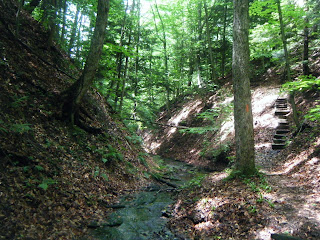 |
| Grinnin' at the start of the Conservation Trail just outside of Ellicottville |
Now I must be honest...I was damn happy to see this branch trail as the main Finger Lakes Trail had put me through the wringer, giving me a taste of all the challenging aspects of this trail (all that I know of at this point at least). I had lost track of the trail for a short period of time and had to double back, I had dodged some loggers when I realized I was on closed trail and then had to reroute myself down miles of country road to get to the next access point to the trail, I had clawed through waist high weeds in lumpy rolling farm hills, and above all I had slogged, sloshed, and slid my way through mud, mud, and more mud.
However....what I didn't realize upon boarding the ride that the Conservation Trail has proven to be was that I was leaving the round-top mountainous region of the western New York and entering the northwestern lowland....where the mud only got deeper...especially when it rained.
 |
| The last round-top mountains I saw on the main FLT |
 |
| A typical sight while walking along the tractor trails through farm land |
 |
| A particularly wet part of the trail walking below the powerlines |
As a result, the Conservation Trail has not had the steep up and downs with which the main FLT was regularly putting along my path, but it has had all of the other challenges, only greater. The CT travels through a great deal of private property and so is regularly being rerouted as landowners dictate - they may need the land for logging, hunting, or simply wish to not have hikers going through their backyard. As a result, the trail winds and squiggles through the woods and with many of these properties being closed from October through May for hunting season as well as the small foot traffic this trail seems to see, these woods paths have grown up. The blazing is excellent thanks to the diligent work of volunteers like the Foothills Trail Club and FLTC trail crews in the area, but one cannot help the vegetation that naturally takes over. In many places there is essentially no footpath and so one must tromp on keeping a close lookout for trees bearing orange paint. Much of the land is evergreen and mixed hardwood forest, marshy grassy swaths and freshly tilled or fallow farmland.
But then there are considerable stretches of pristine trail that makes one realize how much work it takes to actually make a trail and what an incredible pleasurable experience it is to set your body to cruise control and just take in the sights.
 |
| Hunter's Creek Park - boardwalk completed by the FLTC Alley Cat Crew 2011 |
 |
| Trail just outside of the tiny town of Holland - notice the orange blaze on tree and stairs to right placed by FLTC Alley Cat Crew 2008-2010 |
Now all of this technically difficult and messy hiking may not sound all that appealing but there are perks, believe me. Such as the sound of rain falling on the tin roof of a shelter in Darien Lakes State Park while lightening bugs flicker around your head and the woods suddenly brighten and go black as lightening flashes...or the whirring of nighttime insects and croaking of toads in the marshy streams that flow slowly past nearly every place you sleep and the raindrops that seem to cling to each white petal of a blackberry flower whose brambles you had cursed moments before and sit carefully poised atop each leaf of a Jewelweed plant, and you are reminded of just how it got its name. Oh and the wild flower snacks of the common waste place weeds like Dame's Rocket and Yellow Wood Sorrel and Field Garlic bulblets....and let's not forget the wildlife and farm animals and fun signs too...
 |
| Apparently in Erie County you should be on your awares for cowgirls riding tractors |
Last but not least, I have also had the help and company of some incredible folks...this trail may be one of solitude but the few I have encountered have been quality. I want to showcase these folks in their own post to follow this one, so please do check that one out as well!
Also, I'll be posting more pics regularly to my facebook page: The Botanical Hiker, so if you want some more insight to what plant life is out here as well as what's it's like to be out here on this trek, be sure to click on the link to the left of this page or click on this link to follow me: https://www.facebook.com/thebotanicalhiker



Salam sehat
ReplyDeleteThanks for the information
ReplyDeleteJust a minor correction: That portion of the boardwalk shown in the photo was installed by the Western New York Mountain Bicycling Association in 1995. Other boardwalk portions along the trail in the park were installed by Alley Cat (with WNYMBA help) in 2011.
ReplyDelete